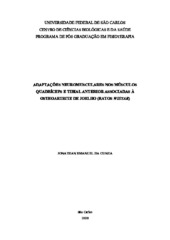| dc.contributor.author | Cunha, Jonathan Emanuel da | |
| dc.date.accessioned | 2020-05-27T21:53:50Z | |
| dc.date.available | 2020-05-27T21:53:50Z | |
| dc.date.issued | 2020-03-27 | |
| dc.identifier.citation | CUNHA, Jonathan Emanuel da. Adaptações neuromusculares nos músculos quadríceps e tibial anterior associadas à osteoartrite de joelho (ratos Wistar). 2020. Tese (Doutorado em Fisioterapia) – Universidade Federal de São Carlos, São Carlos, 2020. Disponível em: https://repositorio.ufscar.br/handle/ufscar/12827. | * |
| dc.identifier.uri | https://repositorio.ufscar.br/handle/ufscar/12827 | |
| dc.description.abstract | Knee osteoarthritis (KOA) is one of the most disabling diseases in the world. This disease is characterized by cartilage damage, narrowing of the joint space, synovitis, osteophytes formation, joint pain and stiffness. The neuromuscular system is also very affected in KOA, however, the mechanisms of neuromuscular changes involved with this disease are poorly understood. Thus, this thesis has two main objectives: 1) Assess for changes in the neuromuscular junctions (NMJ) in rats with induced KOA anterior cruciate ligament transection (TLCA); 2) Check for KOA muscle fibrosis and correlates with muscle atrophy and inflammation. For the first study, 12 adult Wistar rats that were divided into two groups: control (without intervention, n = 6) and KOA (ALCT surgery, n = 6), after 59 days, functional tests were performed (gait test, pain, edema, knee surface temperature). In the next day the animals were euthanized, the quadriceps, tibialis anterior (TA) and gastrocnemius muscles were removed weighed and analyzed (cross sectional area of the muscle fibers, neuromuscular junction morphology, gene and protein expression), the synovial fluid was used to evaluate the total and differential leukocyte number and joint histology were also analyzed. In the second study 12 adult Wistar rats were equally divided into the control and KOA groups. 59 days after TLCA, functional tests were performed (gait test, thermal threshold and mechanical threshold), the following day the TA muscle was removed for analysis (cross-sectional area, percentage of connective tissue, gene expression and zymography). The main results found in the first study were changes in the morphology of NMJ in the quadriceps and TA, greater atrophy in TA than in the quadriceps, genetic and protein changes linked to atrophy and NMJ, in addition to changes in the gait test and functional tests. In the second study, we found muscle fibrosis in TA associated with atrophy and increased of genes expression linked to muscle inflammation. Our results in both studies help to clarify the possible mechanisms of atrophy and muscle weakness linked with KOA. We have seen that although most of the studies evaluate only the quadriceps muscle, TA muscle also seems to suffer modifications due to joint inflammation of the knee, so new studies may help to understand even better the TA remodeling mechanisms, putting on shows that it takes a broad look at the clinical treatment of this disease. | eng |
| dc.description.sponsorship | Fundação de Amparo à Pesquisa do Estado de São Paulo (FAPESP) | por |
| dc.language.iso | por | por |
| dc.publisher | Universidade Federal de São Carlos | por |
| dc.rights | Attribution-NonCommercial-NoDerivs 3.0 Brazil | * |
| dc.rights.uri | http://creativecommons.org/licenses/by-nc-nd/3.0/br/ | * |
| dc.subject | Osteoartrite de joelho | por |
| dc.subject | Junção neuromuscular | por |
| dc.subject | Atrofia | por |
| dc.subject | Fibrose | por |
| dc.subject | Inflamação | por |
| dc.subject | Quadríceps | por |
| dc.subject | Tibial anterior | por |
| dc.subject | Knee osteoarthritis | eng |
| dc.subject | Neuromuscular junction | eng |
| dc.subject | Muscle atrophy | eng |
| dc.subject | Fibrosis | eng |
| dc.subject | Inflammation | eng |
| dc.subject | Tibialis anterior muscle | eng |
| dc.title | Adaptações neuromusculares nos músculos quadríceps e tibial anterior associadas à osteoartrite de joelho (ratos Wistar) | por |
| dc.title.alternative | Neuromuscular adaptations in the quadriceps and anterior tibial muscles associated with knee osteoarthritis (Wistar ratos) | eng |
| dc.type | Tese | por |
| dc.contributor.advisor1 | Salvini, Tânia de Fátima | |
| dc.contributor.advisor1Lattes | http://lattes.cnpq.br/4391969032505723 | por |
| dc.contributor.advisor-co1 | Castro, Paula Aiello Tomé de Souza | |
| dc.contributor.advisor-co1Lattes | http://lattes.cnpq.br/4565741478061291 | por |
| dc.description.resumo | A osteoartrite de joelho (OAJ) é uma das doenças que mais causa incapacidade no mundo. Essa doença é caracterizada por danos na cartilagem, estreitamento do espaço articular, sinovite, formação de osteófitos, dor e rigidez articular. O sistema neuromuscular é muito afetado na OAJ, porém, os mecanismos de alterações neuromusculares envolvidos com essa doença são pouco esclarecidos. Assim, esta tese tem dois objetivos principais: 1) Avaliar se há modificações nas junções neuromusculares (JNM) em ratos com OAJ induzida por transecção do ligamento cruzado anterior (TLCA); 2) Verificar se há fibrose muscular na OAJ e correlacionar com atrofia e inflamação muscular. Foram realizados dois estudos, para o primeiro estudo 12 ratos Wistar adultos foram divididos em dois grupos: controle (sem intervenção, n=6) e OAJ (cirurgia de TLCA, n=6), após 59 dias foram realizados os testes funcionais (teste de marcha, dor, edema, temperatura da superfície do joelho). No dia seguinte os animais foram eutanasiados, os músculos quadríceps, tibial anterior (TA) e gastrocnêmio foram retirados pesados e analisados (área transversal das fibras musculares, morfologia da junção neuromuscular e expressão gênica e proteica), o liquido sinovial foi usado para avaliar o número de leucócitos total, contagem diferencial e a articulação do joelho foi usada para avaliar a histologia articular. No segundo estudo 12 Ratos Wistar adultos foram igualmente divididos nos grupos controle e OAJ. 59 dias depois da TLCA foram realizados testes funcionais (teste de marcha, sensibilidade térmica e sensibilidade mecânica), no dia seguinte o músculo TA foi retirado para analises (área de secção transversal, porcentagem de tecido conectivo, expressão gênica e zimografia). Os principais resultados encontrados no primeiro estudo foram a modificação da morfologia da JNM no quadríceps e TA, maior atrofia do TA que no quadríceps, mudanças genéticas e proteicas ligadas a atrofia e à JNM, além de mudanças no teste de marcha e testes funcionais. No segundo foi observado fibrose muscular no TA associada a atrofia e maior expressão de genes ligados a inflamação muscular. Nossos resultados em ambos os estudos ajudam a esclarecer os possíveis mecanismos de atrofia e fraqueza muscular observados na OAJ. Vimos que apesar da maioria dos estudos avaliar apenas o músculo quadríceps, o músculo TA também parece sofrer modificações decorrentes da inflamação articular do joelho, assim novos estudos podem ajudar a compreender ainda melhor os mecanismos remodelamento do TA, colocando em evidência que é preciso um amplo olhar para o tratamento clínico dessa doença. | por |
| dc.publisher.initials | UFSCar | por |
| dc.publisher.program | Programa de Pós-Graduação em Fisioterapia - PPGFt | por |
| dc.subject.cnpq | CIENCIAS DA SAUDE::FISIOTERAPIA E TERAPIA OCUPACIONAL | por |
| dc.description.sponsorshipId | CNPq: 155210/2016-1 | por |
| dc.description.sponsorshipId | CNPq: 302169/2018-0 | por |
| dc.description.sponsorshipId | CAPES: Código de Financiamento 001 | por |
| dc.description.sponsorshipId | FAPESP: 2017/24192-7 | por |
| dc.description.sponsorshipId | FAPESP: 2016/24666-6 | por |
| dc.publisher.address | Câmpus São Carlos | por |
| dc.contributor.authorlattes | http://lattes.cnpq.br/2254025082364867 | por |


